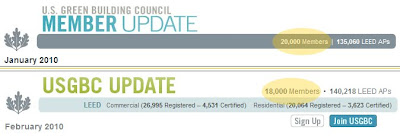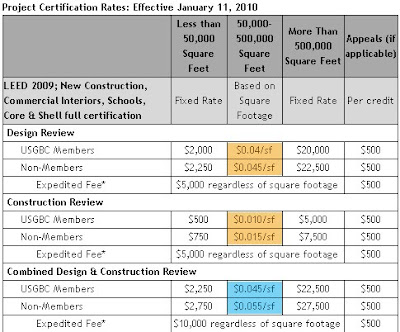I recieved a call from a project architect this morning who had designed a large LEED Core and Shell v2.0 project who in turn had received a call from another architect who is working on a LEED Commercial Interiors v3.0 (2009 edition) upfit of the same building. While we were able to earn 2 points for reducing expected water use by 30.1% in the LEED-CS submittal, when the upfit architects were looking at the water use reductions based on the LEED-CI requirements they determined that the anticipated reduction was only 10.8%. This level of reduction doesn't even meet the new 20% reduction requirement found in the WEp1, Water Use Reduction prerequisite!* What happened? Did we miscalculate the original submittal?

The Unusable Faucet... The latest in water use reduction technology
We (or rather our consultant engineer) didn't miscalculate anything! After taking a closer look at comparing the calculations for both the v3 and v2 editions, we discovered that LEED has adjusted the baseline rate for public faucets from 2.2 gpm down to 0.5 gpm, meaning that while we had substantial flow rate reductions in the LEED-CS v2.0 submittal, none could be claimed for the LEED-CI v3.0 calculation even though the fixture specs were the same. The updated baseline standard applies to v3 editions of LEED-NC, LEED-CS, LEED-Schools, and LEED-CI systems. The change stems from the inclusing of the "maximum [flow rate] incorporated into the national Uniform Plumbing Code and the International Plumbing Code[s]" into the updated requirements. LEED-EB:OM v3.0 sets the anticipated baseline on these standards, but that was the case on the v2 edition as well so nothing has changed there from what I can see.
While the v2 baselines applied a 2.2 gpm baseline requirement for all bathroom lavatories, the v3 system distinguishes between 'public' and 'private' commercial restrooms and residential bathrooms. A private restroom is anything that would regularly be used by only one person at a time: hotel/motel guest bathrooms, hospital patient room bathrooms, and arguably bathrooms serving single offices (e.g. bathroom in the CEO's office used only by that person). All residential bathrooms and these private bathrooms are still held to the same 2.2 gpm baseline as before. Everything else (hotel lobby, shared office, school, and retail and restaurant bathrooms, etc.) are now held to the .5 gpm baseline.
I should point out that I think this is a good change... it's ridiculous to put anything other than a .5 gpm in sinks that will likely never be used for anything other than handwashing or perhaps brushing your teeth, especially when you consider a .5 gpm replacement aerator costs about $2. It also makes sense to keep private bathrooms to a higher standard, since people may be filling coffee pots or other containers that could be annoying if you were limited to such a low flow rate. I've installed a variable flow rate faucet in my kitchen that works great since I leave it on the low setting until I need to fill something up, but my bathroom sink uses a .5 gpm aerator. I should point out that people using on-demand water heaters may have problems in that the flow rate is so low that it may not trigger the water heater to turn on!
Bottom line... I think this is another instance of LEED moving in the right direction by tightening the requirements a bit, but people used to the v2 systems such as myself should definitely make a point to realize that a 20% reduction in v2 is not necessarily 20% in v3. Disagree with me? Please let me know by leaving a comment!
*I should note here that as the bathrooms in question are part of the shared core space of the facility, they should presumably not impact the LEED-CI calculations at all since they are outside of the scope of the upfit**, but any project that upgraded or is considering upgrading from a v2 system to it's v3 equivalent should take note of this change and evaluate the impact on their scores and ability to meet the WEp1 prerequisite.
**NOTE - 02.17.10 - Nathan has questioned the accuracy of the assumption that the existing fixtures would be outside of the scope of the prerequisite in the comments, and I don't have an 2009 IDC reference guide on-hand to refer to so I can provide a definitive answer. I've always been a little hazy on how the scope of a LEED-CI project is set, and since I don't have direct experience in LEED-CI I could very possibly be wrong!








